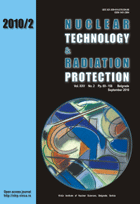
THE UNFOLDING EFFECTS OF TRANSFER FUNCTIONS AND PROCESSING OF THE PULSE HEIGHT DISTRIBUTIONS

Vol.
XXV, No. 2, Pp. 69-156
September 2010
UDC 621.039+614.876:504.06
ISSN 1451-3994
Pages: 93-99
Authors: Senada Avdić, Predrag Marinković, Bećo Pehlivanović
AbstractThis paper deals with the improvements of the linear artificial neural network unfolding approach aimed at accurately determining the incident neutron spectrum. The effects of the transfer functions and pre-processing of the simulated pulse height distributions from liquid scintillation detectors on the artificial neural networks performance have been studied. A better energy resolution and higher reliability of the linear artificial neural network technique have been achieved after implementation of the results of this study. The optimized structure of the network was used to unfold both monoenergetic and continuous neutron energy spectra, such as the spectra of 252Cf and 241Am–Be sources, traditionally used in the nuclear safeguards experiments. We have demonstrated that the artificial neural network energy resolution of 0.1MeV is comparable with the one obtained by the reference maximum likelihood expectation-maximization method which was implemented by using the one step late algorithm. Although the maximum likelihood algorithm provides the unfolded results of higher accuracy, especially for continuous neutron sources, the artificial neural network approach with the improved performances is more suitable for fast and robust determination of the neutron spectra with sufficient accuracy.
Key words: unfolding, neutron spectra, pulse height distribution, MCNP-PoliMi numerical code, linear ANN, maximum likelihood method
FULL PAPER IN PDF FORMAT (792 KB)
Last updated on September, 2010